Las Tamaleras
Keeping family tradition alive

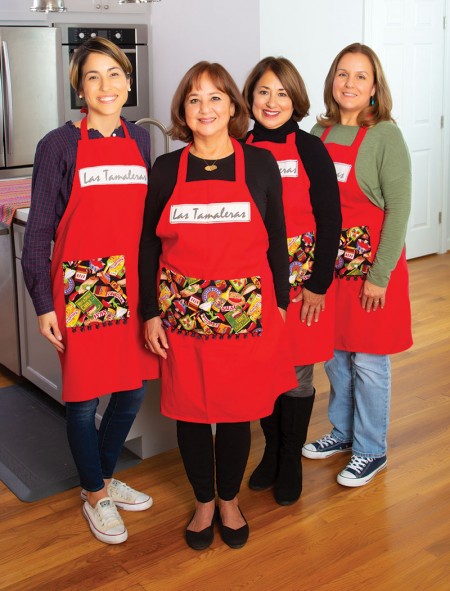
Katherine Smith, Irene Townsend, Irma Bujnoch and Theresa Mickiewicz carry on their family’s tradition of making tamales for Christmas every year. (Photo: lawellphoto.com)
Every December 23, before the sun begins to rise, the women in the extended Ramirez family gather together around a kitchen table. There, in the heart of the home, surrounded by heaping bowls of masa, savory pulled pork and corn husks, they don matching red aprons and make tamales from a recipe that has been passed down for generations.
They call themselves “Las Tamaleras” – the tamale women – and as they work, they tell stories and continue the legacy of their family matriarch, Elodia “Mimi” Ramirez, who long oversaw their Christmas Eve tamale tradition, started more than 70 years ago.
“I have done this my whole life, and it has been done for generations before me,” says Theresa Mickiewicz, who lives in Southampton with husband Cyril and daughters Lizzie and Julia. “My grandmother is no longer with us, but she was the greatest cook and she loved you through food. My mom is one of her four daughters [Irene, Becky, Irma and Mary Ann] who all grew up making the tamales on the 23rd and eating them on Christmas Eve.”
Family lore has the story of Elodia getting married to Joseph Ramirez, and continuing the tradition learned from her grandmother, who raised her after her mother died when she was 7 years old. “Even though I never knew my great-great-grandmother, who was born in Mexico, I can imagine them sitting around a table making these tamales, and I can imagine my grandmother learning at her side,” says Theresa. “I am the fifth generation making the tamales, and my daughters, Lizzie and Julia, are the sixth generation.”
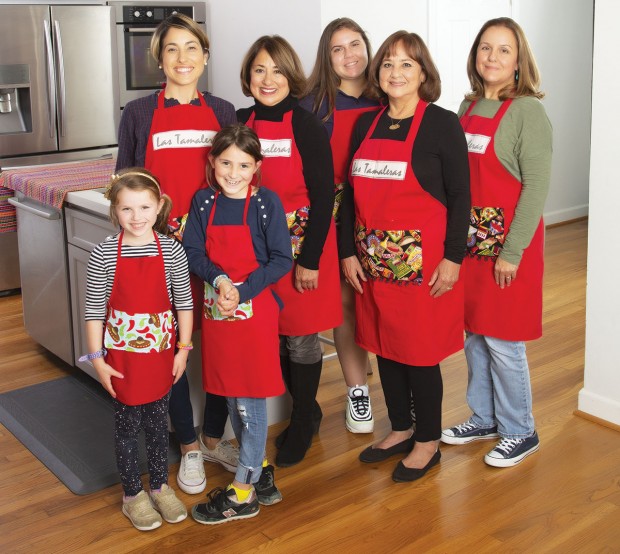
MOTHERS AND DAUGHTERS Three generations of Ramirez women get ready to make tamales. Front row, from left: Sloane Smith, Quinn Smith. Back row, from left: Katherine Smith, Irma Bujnoch, Lizzie Mickiewicz, Irene Townsend, Theresa Mickiewicz. (Photo: lawellphoto.com)
Theresa says the multi-step tamale process seems as long as their family has been making them. It is an assembly line-like production, led by one woman. Elodia passed the baton to Theresa’s mother, Irene. Now, Irene is passing it along to Theresa. It’s not a job to be taken lightly, either. “This is my year to learn,” says Theresa, with equal parts excitement and trepidation. “I was talking to my mom, and she said this is my year. It is a very time-consuming process to make the tamales, to put them together, to steam them. But it is part of my identity. It is a part of who I am.”
For these women, making tamales is more than just cooking, it is a time-honored event that binds them as tightly as the corn husks they use to wrap up the masa and the meat. “This tradition is sacred,” says Irene Townsend, Theresa’s mother. "It is family time shared with my parents in the past, my sisters, our daughters and, now, our granddaughters. It is a time of story-telling, joke-telling and catching up with family happenings.”
Each person is delegated a role in creating the tamales. The leader is the designated pork shoulder cooker. “My mom usually gets up at 3 a.m. and starts making the meat,” says Theresa. “It has to be cooked with the spices and has to be tasted and flavored right. Back in the day, my grandfather was always out and about, but he would come in the kitchen to taste the meat and he would he would tell you exactly what it needed for seasoning.” Once the pork is cooked, it has to cool down and be shredded. And then the masa has to be made. “Masa is the outside corn base that surrounds the tamale,” says Theresa. “It is made in a huge pot on the table, and it is a lot of work.”
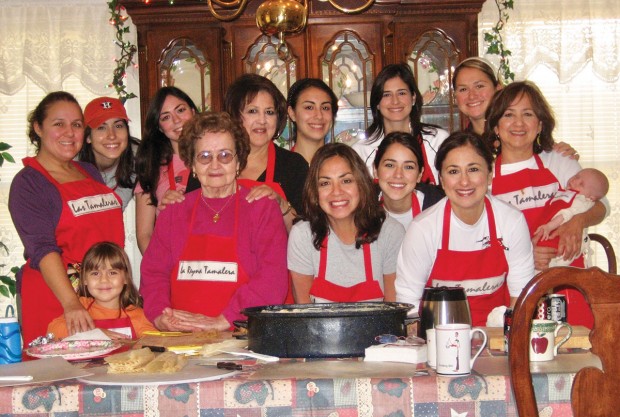
WE ARE FAMILY For more than 70 years, the women in the extended Ramirez family have gathered on Dec. 23 to make tamales for Christmas.
After the masa is complete, the assembly begins, and everyone is assigned their roles. Some of the women spread the masa onto the corn husks, others ladle out the meat onto the masa, and others fold, wrap and finish the tamales. One person does quality control to make sure the tamales are made just right, and others are designated story (and joke) tellers to keep everyone entertained as they spend the day working, singing and dancing.
“We all know everyone has their role, who is the taster and who is quality control or those of us who sit at the table and spread the masa,” says Katherine Smith, Theresa’s first cousin, and whose mother is Irma Bujnoch, Irene’s sister. “My aunt Becky is the story teller, and she tells the story of their childhood, and every year it is the same story, but it is keeping our family history alive. We are third-generation Americans, and while we have varying degrees of how alive our heritage is – some of us speak Spanish and some of us don’t – it’s a way to hang onto our heritage and our culture and remind us of our history.”
That familial history is important, they all say. “I think about how blessed we are as a family to be born into this rich heritage,” says Irene. “I am so thankful to our parents who loved and nurtured us. I cherish my mother, who was the epitome of a strong and caring woman. And I love this poem by Nayyirah Waheed: ‘My mother was my first country. The first place I ever lived.’ I hope our children will think of us with a fraction of that fondness.”

MEMORIES OF MOM This photo of Elodia Ramirez was taken in 1942. The extended Ramirez family makes tamales every Christmas with Elodia’s recipe.
Weaving their family history into their tamale-making honors Elodia Ramirez. “It is a wonderful tradition that we have wanted to carry on through different generations, which carries on the love of our mother and what she did for us,” says Irma Bujnoch, who also lives in Southampton near daughter Katherine and niece Theresa. “To me, I feel like we can feel the presence of my mother when we are making these. And she is probably getting a big laugh as we tell the stories. She had a really great sense of humor.”
The aprons they all wear also play a part of the day. The custom red aprons are embroidered with the words “Las Tamaleras,” but there are also two special ones that read La Reina Tamalera [Queen Tamalera] that belonged to Elodia and one that says La Chiquita Tamalera (The Littlest Tamalera) for the youngest child present. “We hang her La Reina Tamalera apron up every time we make tamales,” says Irene. Katherine and her husband Justin’s daughters, Quinn, 8, and Sloane, 5, also join in making the tamales and take turns wearing the La Chiquita apron.
Even though most of the family is rooted in Houston, there are some members who live in other places: California, Colorado, Virginia and Australia. They are always welcomed home to make – and then eat – the tamales.
On December 24, the tamales are steamed and are ready to eat when the family gathers together. "When we were young, we would go to Midnight Mass and come home and open presents and eat a big tamale dinner complete with rice, beans, guacamole, chips and dessert,” says Irene. “As we got older and had our own families, we would all get together around 6 p.m. on Christmas Eve and eat a big tamale dinner with all the trimmings. The children would put on a play. The first play was The Christmas Story from Luke. There were costumes, painted backdrops, a 6-month old baby Jesus [Katherine] who got pushed out in a woven basket, and Theresa was the Virgin Mary. Everyone would leave around 11 p.m. to go to Midnight Mass. We still do the big dinner, the grandkids open presents, we sing, dance and tell the same old stories, as well as a few new ones. It’s great!”
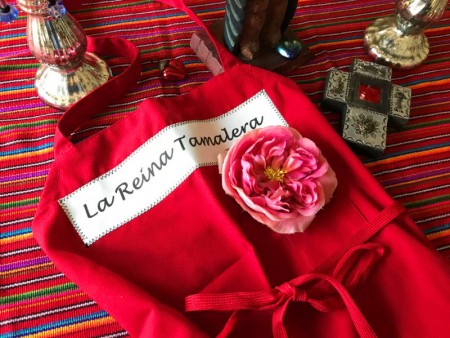
LA REINA TAMALERA The stitching on the apron, La Reina Tamalera, translates to The Queen Tamale Maker and was worn by Elodia Ramirez. Her family made it for her and she wore it on every occasion of making the family tamales. The Ramirez family members ceremoniously hang Elodia’s apron up every December when they make the tamales.
“Of course our husbands love it because they benefit from it,” laughs Irma, who says the tamales have always been made exclusively by the Ramirez women. “We used to have tamale-eating contests to see who could eat the most. It really is so fun!”
And although the Christmas Eve celebration has evolved over the years, the sentiment remains the same, with the taste of the tamales taking them back to Elodia’s kitchen. “The tamales are so good and spicy. Our friends always say they are the best,” says Irene. “We do not use a lot of masa and we add a lot of meat, so they are really tasty.”
Theresa could not agree more. “They are my favorite on Christmas Eve,” she says. “They are better than anything than I have ever had. They are not doughy at all, and the masa that we make does not get clumpy or hard. I have never had anything that tastes this good. It tastes like going to Grandma’s when I was little.”
There are a lot of feelings and memories wrapped up in these tamales. “This is one of the only authentic connections I have to my culture, and that is huge,” says Katherine. “It is amazing how food can keep you tied to that. It’s not just the food itself – it is the act of making it. Making the tamales is a way to keep our culture alive – to not forget who we are and where we come from. We were all raised to be special, and we were not told we had any limits, and I attribute that to my grandmother. Making tamales is more about finding happy things to lean into.”
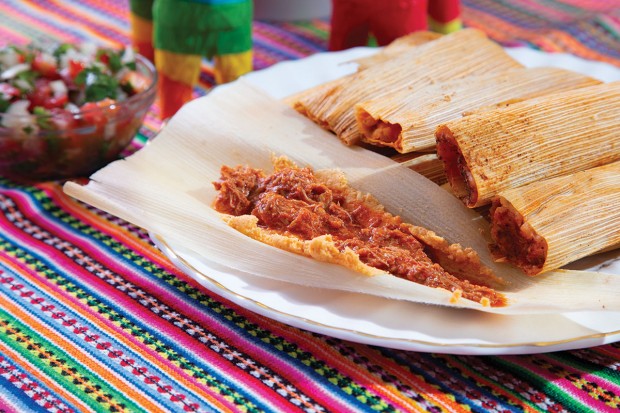
FAMILY RECIPE The pork tamales are the stars of the Ramirez family Christmas celebration and are made in a multi-day process. (Photo: lawellphoto.com)
Filling: 8 pounds pork shoulder
1 bunch fresh garlic, slivered
1 teaspoon salt
8 chili arbol peppers, washed and split with seeds and stems removed
8 Serrano peppers
Red Chili Sauce: 20 large dried guajillo peppers, washed and split with stems and seeds removed
6 chili arbol peppers, washed and split with seeds removed
½ large yellow onion, quartered
4½ cups water
2 garlic cloves, peeled
1 Tablespoon chicken bouillon seasoning
Masa: 10 pounds fresh prepared masa (purchase at Fiesta Market Bakery section the day of tamale making)
1 pound lard, melted
½ cup broth from pork
½ cup red chili sauce
2 teaspoons ground cumin
2 teaspoons chili powder
Salt to taste
Corn Husks: 2 16-ounce packages of corn husks
Day 1: Grocery shopping and cooking the pork roast and red chili sauce.
Trim thick fat layer from the pork. Cut pork roast into large three-inch chunks. Make slits in the pork and insert large slivers of garlic. Place the pork in a large stock pot with enough water to cover it completely. Add salt and chili arbol and Serrano peppers. Bring to a boil over high heat. Reduce heat and simmer for 3 hours. Remove pork from pan and let it cool. Save 1 cup of pork stock. When completely cool, shred pork. Store in refrigerator.
While pork is cooking, make red chili sauce. Place peppers, onion, water, garlic and chicken bouillon in a medium-sized pot. Bring to a boil over high heat. Reduce heat and simmer for 20 minutes. When cool, transfer mixture to a blender. Blend for 1 minute. Strain blended mixture through a sieve to remove solids. Store in refrigerator.
Day 2: This is the day the family gathers to make the tamales.
Purchase prepared masa from the bakery department of Fiesta Market on Bellaire Boulevard. It is better to buy it the day of the tamalera party. Mix the prepared masa, melted lard, pork broth, red chili sauce and seasonings. Knead to a smooth consistency. Adjust seasonings as needed. After kneading, you should be able to remove your hand without the masa sticking to it.
Wash corn husks thoroughly, removing any silk. Place husks in a large container of warm water. Hold husks down with a heavy object to keep the husks submerged in the water for one hour.
Combine pork and ½ red chili sauce mixture. Adjust seasonings. Set aside.
Remove husks from water, shake excess water off and place husks on a large platter.
For each tamale: Spread about 2 tablespoons of masa on the smooth side of each husk (about 1⁄8-inch thickness), leaving about 3 inches at the pointed end. Add about 1 tablespoon of pork mixture to the center of the masa and roll up the husk. Fold the pointed end of the husk (without the masa) under and add a little masa to the other end to seal. Repeat until all the masa and pork are used. Stack the tamales flat in a container and refrigerate overnight.
Day 3: Steaming the tamales.
To steam the tamales, place them in a large stock pot with a raised rack. Place a penny in the bottom of the pot. When the water level becomes low, the penny will begin to rattle, indicating you need to add more water to the pot. The tamales should remain above the water line. Stack the tamales, teepee-style with the open end of the tamales pointed toward the center. Place a loose layer of husks over the tamales. Cover the pot and steam the tamales over low heat for 90 minutes. Turn off the heat and leave on burner for an additional 30 minutes. Tamales are done when you can easily peel them from the husks.
Makes about 10 dozen. We often double the recipe.
Want more buzz like this? Sign up for our Morning Buzz emails.
To leave a comment, please log in or create an account with The Buzz Magazines, Disqus, Facebook, or Twitter. Or you may post as a guest.


